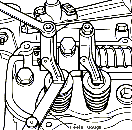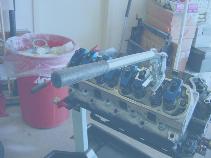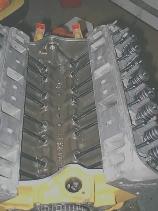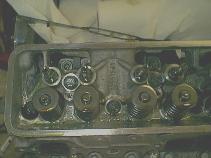Hydraulic valves do not need adjusting. Hydraulic arm must be replaced
--------
[http://www.geocities.com/MotorCity/Garage/5007/fiero_osg/lifters.html.]
Hydarulic valve lifters require very clean oil to function properly due to the very small internal clearances inside them.
Any oil contamination can either cause the lifter to stick or can cause the clearance to wear causing lost motion in the valve train and a small amount of noise.
I suspect that is your problem judging from the mileage and minor character of the noise.
They require no adjustments - ever. Tightening down the lash nut on the rocker is not a correct procedure for eliminating noise in the valve train. Doing so does, however, run the risk of collapsing the lifter and breaking something - likely the push rod but possibly something more expensive. Magic lubricants that claim to be able to unstick a "sticky lifter" do not work in about 99.7% of cases. They are a waste of money.
The only sure way to eliminate valve train noise is to replace the lifters - you really should do the whole set at once. There are 12 in a V6 and they likely don't cost more than about $10 each. You will need to remove the plenum and intake manifold and the lifters can normally be fished out with a small piece of wire with a hook bent into one end.
-------------

 [http://members.aol.com/carleyware/library/misfire.htm.] A lean mixture in a single cylinder can be caused by a leaky intake manifold gasket, air leakage past injector O-rings, a leaky EGR valve (if the valve is adjacent to the cylinder intake port) or a dirty, plugged or inoperative fuel injector. Loss of compression because of a leaky (burned) exhaust valve or a leaky head gasket can also affect the spark burn line in the same way
[http://members.aol.com/carleyware/library/misfire.htm.] A lean mixture in a single cylinder can be caused by a leaky intake manifold gasket, air leakage past injector O-rings, a leaky EGR valve (if the valve is adjacent to the cylinder intake port) or a dirty, plugged or inoperative fuel injector. Loss of compression because of a leaky (burned) exhaust valve or a leaky head gasket can also affect the spark burn line in the same way---------------
[http://www.tigersunited.com/wsm/wsmB18.asp.] Needle fluctuates steadily as speed increases: -
A partial or complete loss of power in one or more cylinders caused by a leaking valve, cylinder head or intake manifold gasket leak, a defect in the ignition system or a weak valve spring.
--------
[ttp://www.iequus.com/manuals/3222E.pdf.] Burnt, leaky, or sticking valves: If the valves are burnt or leaking, the vacuum reading will dropevery time the defective valve or valves are inoperative. Anintermittent drop Indicates sticking valves
--------------
[http://www.international-auto.com/vacgauge.html.] Needle drops sharply on a regular rhythm Burnt valve, or a valve with clearance too tight
--------------
[http://www.birfield.com/archives/html/landcruisers/2003-03/msg02427.html.] (for Toyota Land Cruisers) So what I thought was going to be an intake manifold heat crack turned out to be a vacuum leak after all. A loose tensioning nut on the carb (Weber) butterfly shaft caused the intermittent air leak and rough idle symptoms only when the engine warmed up to operating temperature. Might be worth a look for those who run the 38mm Weber.
So after a bunch of hours of quality time under the hood, adjusting valves, replacing vacuum tubing, pulling carburetor, peering into the intake manafold and avoiding honey-do chores - it turned out that all it took was 20 seconds with a wrench to get my smooth idle back again. Jeff Zepps year-old advice to "get rid of that crappy little Weber and get a Jim C rebuild" is ringing in my ears, but for now I am satisfied with the performance. Life is good!
---------------
[http://www.2carpros.com/makes/dodge/colt.htm.] The intermittent problems you described are hard to diagnose. If possible, the car should be checked when the problem is present. When your car stalls, check for spark at the spark plugs, to isolate trouble in the ignition system. Next, test the fuel pressure to eliminate fuel pump and pump relay problems. You said you replaced the ignition coil; did you replace the ignition module as well?
--------------
[Valves, etc.]
[http://www.uniglide.co.za/product_info/faq_engine.html. ] Q. Why do I need to use Uniglide Engine Flush? Why do I really need to flush my engine and, if I need to flush my engine, how often should I do this? A. If your equipment is regularly maintained to manufacturer's recommendations, using engine flush would be recommended only once every two years. However, if services are skipped, or sub-standard lubricants have been used, or a used machine has been purchased, we would recommend it be flushed as a precautionary measure.
Q. Will Uniglide Engine Flush help to loosen sticky rings and sticking valves? Can it clean deposits on intake valves and exhaust valves?
A. Yes.
Q. Can the Uniglide Engine Flush help with sludging problems?
A. Yes, not only in engines but in gearboxes too.
Q. Why do I need to make an engine hot before Uniglide Engine Flush can do it's job properly?
A. Because it requires heat for the detergents in the flush to dissolve the unwanted deposits properly.
Q. After using Uniglide Engine Flush, will any residual flush not drained completely have any detrimental effects on the new oil?
A. No, in fact it will add to the detergent ability of the new oil
Q. What is in the Engine Flush that makes it so effective?
A. Uniglide Engine Flush contains the latest detergent and dispersant chemicals which are the strongest available.
Q. How long should ileave the Engine Flush in the engine before draining the old oil?
A. Maximum 10 minutes, especially in older engines, or the engine flush can do too much cleaning, by removing build-up on valve stems, and cause the engine to smoke afterwards.
---------------------------
[http://www.imperialclub.com/Repair/Engine/tests.htm.]
Assuming you have done the oil down the plug hole trick to see if anything changes? We used to take flathead Fords from Windmachines that had sat all winter and pull the plugs, add wd-40 , etc and crank the daylights out of them. Sometimes a stuck valve or ring would decide to play, other times it wouldn't.
-----------
 [Photo: http://www.cobralads.com/6000000/DSC00082.JPG (Website: http://www.cobralads.com/butcher56.html )
- Compresion tool for valve spring]
[Photo: http://www.cobralads.com/6000000/DSC00082.JPG (Website: http://www.cobralads.com/butcher56.html )
- Compresion tool for valve spring]-----------

 [photo: http://www.houston-f-body.org/tech/LS1Cam/images/pushrods-sm.jpg ; website: http://www.houston-f-body.org/tech/LS1Cam/cam4.html] /
[Photo: http://www.fast351.com/enginerebuild/images/pushrods.jpg ; Website: www.fast351.com/enginerebuild/ index8.htm]
[photo: http://www.houston-f-body.org/tech/LS1Cam/images/pushrods-sm.jpg ; website: http://www.houston-f-body.org/tech/LS1Cam/cam4.html] /
[Photo: http://www.fast351.com/enginerebuild/images/pushrods.jpg ; Website: www.fast351.com/enginerebuild/ index8.htm]


